A total of 222 flight hours has been performed at sea in the framework of the Belgian North Sea aerial survey programme in 2017. In and nearby the Belgian marine areas 11 spillages were observed, of which 10 operational slicks and one accidental spill. During the sulphur emission control flights at sea 49 ships were detected with a high fuel sulphur content. During an international mission for the detection of spillages in the central part of the North Sea where the offshore oil and gas platforms are located, 26 other oil spills were detected. The Scientific Service Management Unit of the North Sea Mathematical Models of the Royal Belgian Institute for Natural Sciences, is responsible for the aerial surveys over sea in Belgium.
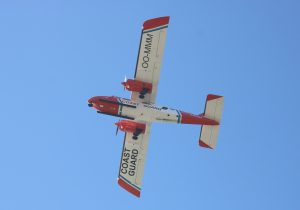
In 2017 a total of 222 flight hours has been performed at sea in the framework of the Belgian North Sea aerial survey programme. Of these flight hours, 187 were performed in the framework of the Belgian coastguard in and nearby Belgian waters, 19 were spent on an international mission for the detection of spillages near oil and gas installations in the central part of the North Sea (the so-called Tour d’horizon mission), and 16 were used for marine mammal monitoring. Of the 187 coastguard hours, 40 were spent on fishery control, two on joint coastguard missions, and 145 on pollution control (MARPOL enforcement at sea). In the last category, 80 hours were specifically dedicated to sulphur emission control flights, and 65 hours to the control of deliberate discharges of oil and other harmful substances.
Operational Discharges
In 2017 a total of 10 operational ship discharges were detected:
- In two cases an oil slick was detected. Both slicks consisted of minor volumes with a limited impact for the marine environment. This result is in line with the trend observed in recent years, of a systematic reduction in annually observed operational oil discharges.
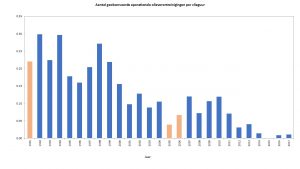
Number of operational oil spills observed per flight hour. © RBINS/SURV - In five cases another harmful substance than oil was detected. Only once however a link could be made with a vessel; it concerned an alleged MARPOL Annex II violation in British waters. The alleged violation was reported to the British authorities for further follow-up. In the four other cases no ship was found in the vicinity of the slicks.
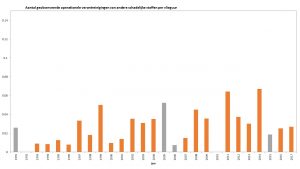
Number of operational contaminations by other harmful substances observed per flight hour. © RBINS/SURV - In the three remaining cases it was impossible to visually verify the substance of the slick due to darkness or bad visibility.
Accidental Marine Pollution
In 2017 only one accidental oil pollution was detected. It concerned oil which got accidentally released from the ‘Fluvius Tamar’ wreck which sunk in January in nearby British waters. The Belgian surveillance aircraft furthermore also performed aerial monitoring of other shipping incidents in and nearby Belgian waters. Luckily however no further accidental marine pollution was observed:
- Following a collision between the bulk carrier ‘Coral Opal’ and the tanker ‘Silent’ in June 2017, the aircraft performed an aerial monitoring flight on site but no pollution was detected.
- In August 2017 another flight was carried out following an alert of the Blankenberge beach rescue service about a small weathered heavy fuel oil slick observed in nearshore waters. During this flight a large part of the coastal waters was scanned but no oil could be found. The initially reported patches of heavy fuel were thought to be weathered oil remains from the ‘Flinterstar’ incident (2015), which probably got trapped in the seabed and were accidentally released in the summer of 2017 due to works near the port of Zeebrugge.
- A third aerial monitoring flight was performed following the stranding of the tanker ‘Seatrout’ in the Western Scheldt near the turn of Bath in September 2017, but again no accidental pollution was detected.
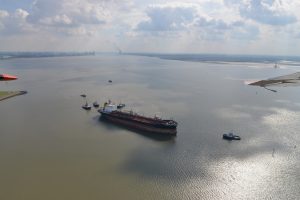
The Seatrout is pulled from a sandbank in the turn of Bath (Western Scheldt) by tuggers. © RBINS/SURV
Sulphur Emission Monitoring
The 80 hours spent monitoring sulphur emission compliance at sea were spread over 51 so-called ‘sniffer’ flights. In this way, the sulphur content in the smoke plume of 870 ships was effectively monitored. 49 of these ships showed suspiciously high sulphur values, and were systematically reported to the competent maritime inspection services for further follow-up in port (‘Port State Control’).
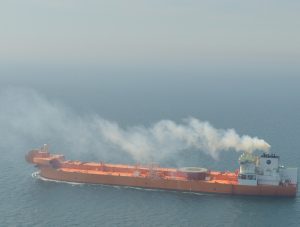
International Mission (Tour d’Horizon)
During the annual international campaign for the detection of spillages in the central part of the North Sea where the oil and gas installations are located, executed in the framework of the Bonn Agreement, 26 oil slicks were detected, of which 22 were connected to platforms, and four were found at sea, without a clear link to a platform or ship. All findings were reported to the competent authorities of the affected coastal States.
Pollution in Belgian Ports
During transit flights in 2017, two oil slicks were detected in the Port of Antwerp. These findings were immediately reported to the competent port authorities for follow-up.
